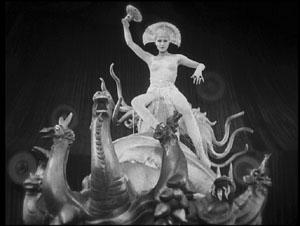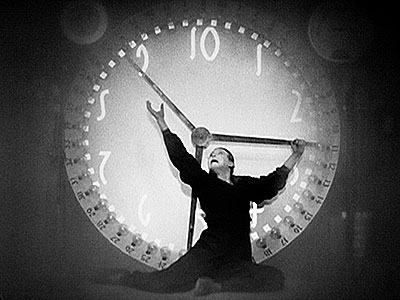

An examination of gender, religion,
and other issues
in one of SciFi's most famous films
| Film Reviews [A.O. Scott] [Kristina Locke ] | ||
 |
A.O. Scott's Review of the 2002 re-release, published in the NY Times see the article on the NY Times website here |
|
On Jan. 10, 1927, Fritz Lang's ''Metropolis,'' a wildly ambitious, hugely expensive science fiction allegory of filial revolt, romantic love, alienated labor and dehumanizing technology opened at the Ufa Palast theater in Berlin. Lang's film, of course, went on to become one of the touchstones of 20th-century cinema, exhaustively studied and endlessly imitated, but apart from its brief theatrical run in Berlin and Nuremberg 75 years ago, the movie as Lang made it has never really been seen. What happened to ''Metropolis'' is, in some ways, a familiar movie-industry story of a studio's interference with an artist's work. (Or, if you prefer to side with the studios, of a filmmaker's profligate indifference to economic necessity and audience response.) A few weeks after the premiere, Ufa, the studio that had produced the film, pulled it from theaters and cut out 7 of the original 12 reels. Paramount, the American distributor, went even further, engaging a playwright, Channing Pollock, to compose English title cards and to reshape the story to fit his own tastes. ''I have given it my meaning,'' Pollock boasted. Lang was so appalled that he swore he would never go to the United States, a vow he broke a few years later, when Hitler proved to be a much graver threat to his art (to say nothing of his life) than Hollywood could ever be. Much of the grandeur and strangeness of ''Metropolis'' survived Paramount's butchery and the further desecration perpetrated in 1984 by Giorgio Moroder, who added color tints to Karl Freund's eerie Expressionist black-and-white cinematography and replaced Gottfried Huppertz's lush, Wagnerian score with the music of pop stars like Freddy Mercury and Bonnie Tyler. Had Lang lived to see the age of the ''director's cut'' DVD, he might have responded to those transgressions and reconstructed a definitive ''Metropolis.'' But now we have something nearly as good. Thanks to four years of painstaking work by Martin Koerber, a German film preservationist, and Alpha-Omega, a Munich company specializing in digital restoration, there is now, at long last, a ''Metropolis'' with a legitimate claim to being definitive. Film Forum on Houston Street may lack the decadent Weimar glamour of the Ufa Palast, but it does serve the best movie house popcorn in Manhattan and, for the next two weeks, will be showing the latest version of ''Metropolis'' in a spotless 35-millimeter print with a new recording of Huppertz's score. Much has been retrieved -- more than 1,300 feet of film have been added since the last rerelease, in 1987 -- and the English titles have been translated anew. There is also a second set of title cards, printed in a plainer font, without multiple exclamation points, to indicate scenes that are still missing. A subplot involving a character called the Thin Man, a mysterious monk and visions inspired by the Book of Revelation remains tantalizingly sketchy, but Lang's visual audacity and thematic ambition are breathtakingly apparent, as is his astonishing sense of scale, which enabled him to swoop from terrifying sublimity to piercing, quiet intimacy with a single cut. Pollock complained that, in Lang's version, ''symbolism ran such riot that people who saw it couldn't tell what the picture was all about.'' He was not altogether wrong: Christianity, German romanticism, modernism and Marxism stampede through the movie like the crowds of angry workers and bourgeois revelers in the apocalyptic climax, but the confusion that results ultimately resolves into hallucinatory, visionary clarity. Only by pushing himself to the very edge of coherence was Lang able to transcend the schematic moralizing that keeps so much science fiction tethered, ultimately, to the mundane. This is not to slight either the emotional impact or the political resonance of Lang's fever-dream of the future. Quite the contrary: ''Metropolis'' retains its power to overwhelm, trouble and move because it is connected to the deep anxieties of modern life as if by a high-voltage cable. The story of the scientist Rotwang (Rudolf Klein-Rogge), a modern Pygmalion designing a female robot to replace his lost love, stands between ''Frankenstein'' and ''A.I.'' as an expression of the defining modern preoccupation with machines that blur the boundary between the human and the mechanical. The early scene of workers trudging into the dark maw of their underground factory has been copied to death (most recently in ''Road to Perdition''), but it remains unsurpassed as an image of how mechanized work for another's profit can strip people of their individuality. Later, as the mob of workers smashes the factory and unleashes a flood of anarchy on the city, we see an equally chilling image of the senseless destruction that revolt against exploitation can produce. In 1927, ''Metropolis'' was attacked by the German left as implicitly fascistic, and by the right for its Communist tendencies. But one of the curiosities of the film is that its aesthetic extremity serves a mild and moderate ideology. The city, run by the suave industrialist Joh Fredersen, is a drastically polarized place, with lush gardens and soaring skyscrapers above ground and infernal slums below. In the depths, a young woman, Maria (Brigitte Helm, the Kirsten Dunst of the Weimar Republic), prophesies the coming of a messianic figure called the Mediator, whose name sums up the temperate, reformist message buried in the movie's sweep and bombast. The Mediator turns out to be Freder Fredersen (Gustav Fröhlich), the boss's sensitive son, whose infatuation with Maria leads him to a moral awakening. His ultimate triumph is delayed by obstacles and digressions too numerous and wonderful for mere prose, and the audience is distracted from the film's moral by its elements of horror, mystery, burlesque and romance. Far from a historical curio, ''Metropolis'' arrives, three-quarters of a century late, like an artifact from the future. At last we have the movie every would-be cinematic visionary has been trying to make since 1927.
|
||
| Kristina Locke's Review of the 1997 VHS edition | ||
Having never seen a silent film before, I was pleasantly surprised by how well the story of Metropolis was told. It is impressive how much of a story can be told through action with only a few bits of text displayed on the screen and no dialogue whatsoever. Before I watched the film, I read a summary of the film from a very inspiring and well-made Metropolis- themed website so that I would be able to keep up with the film as I watched it. As it turned out, reading the summary may have been more of a hindrance than a help as the 1997 version of the movie leaves out some of Fritz Lang's key elements, such as the fact that the robot was made to replace Rotwang's lost lover, not the workers of the lower city. Such omissions only took away from the story and led to confusion in not only myself, but my peers who had not read the summary. I was also very interested in the social commentary - that is, the premonition of the reality of the Nazi Concetration camps represented in the Lower City, and I had to remind myself that the movie was created before any Jewish persecution took place. The political and social overtones are hard to miss, as it is a condemnation of oppression, slavery and an elitist class system. The acting was a bit overdone at parts, but this is forgivable considering that there is no dialogue or vocalisations from the actors, only the orchestra in the background - the extreme actions and overdone facial expressions are needed to convey the true depth of the characters' feelings. There was no lack of feeling in the characters' interactions with each other, and this gives the audience a sense of connection with the characters - despite the fact that there is no dialogue, as most modern audiences are used to, we are able to feel Freder's repulsion upon seeing workers killed in a Lower city explosion and Maria's concern for the wellbeing of the entire city. I felt the ending was a bit unsatisfying if only that we do not see any results of the union between the upper and lower cities, merely the beginnings of an alliance. There is no indication that the working conditions improve or that the Upper city citizens take responsibility for their own development and actually do some manual labor. A more modern Hollywood ending probably would also have opted for a marriage between Freder and Maria, as a more obvious bond between the workers and thinkers. Overall, the film was very well done plot-wise and quite visually impressive for 1920s Germany. Perhaps it is better that the film was edited so much - this version is over two hours long, and if all the footage that was cut was re-added, the resulting movie may be enough to bore even the most dedicated viewer. Fritz Lang's original screenplay would no doubt be more satisfying plot-wise, but since the loss of nearly a quarter of Lang's original film is irreversible, there is no reason not to be content with the story as is. |
||